The Argaric society reached its peak soon after it 1750 BC. By 1500 BC it had vanished
By Nick Nutter | Updated 11 Apr 2023 | Andalucia | History |
Login to add to YOUR Favourites or Read Later
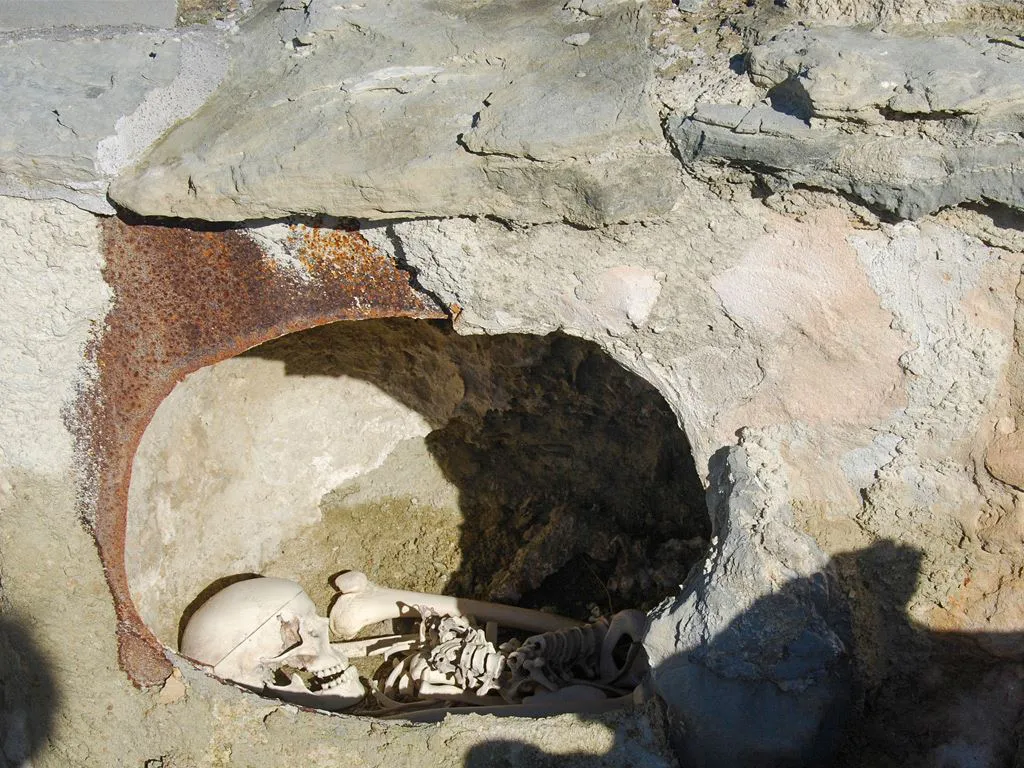
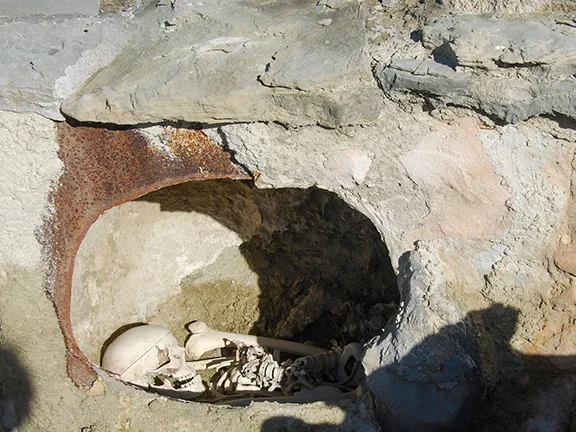
Argar intramural burial
Barely had the Argarian society reached its peak, in development and territory, than it started to implode. Like a chain reaction, the disintegration increased in velocity. This article looks at why the Argarian society fell, how that affected its neighbours and what survived of this first society to establish itself on the Iberian Peninsula.
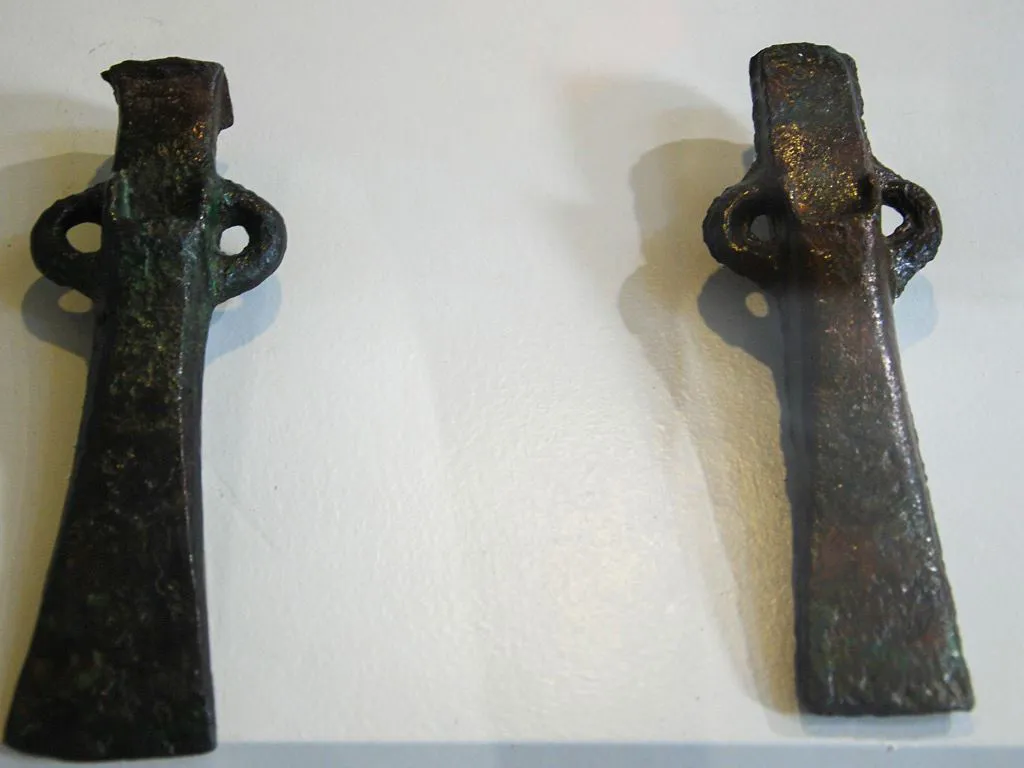
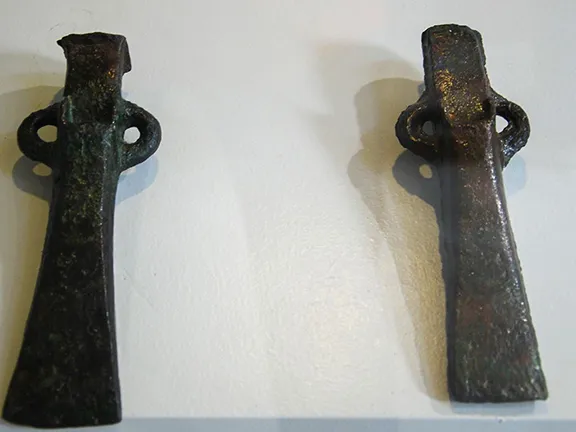
Argar bronze axes
The Argaric society reached its peak soon after it 1750 BC when it had expanded its territory its greatest extent. Available archaeological, anthropological and palaeoecological information allows us to reconstruct the forces that drove the society.
• Rapid economic growth and centralisation in the larger settlements, where larger habitation, production and storage structures were required led to a monumental architecture, which also supported the political superstructure.
• This economic process was not achieved through technological improvements, but through an intensification of the work force involved, as seen by a marked quantitative increase of production means and residues in the archaeological record.
• This labour intensification demanded a growing population and/or the closer tying of the communities to their economic and political centres, resulting in a general increase of the number of intramural interments.
• A subsistence strategy based increasingly on an extensive, rain-fed, barley monoculture fed this growing or more dependant population, but at the cost of soil depletion and salinisation processes, which in turn forced agricultural expansion and a progressive deforestation evident in the palaeobotanical records.
• Anthropological and pathological observations hint towards a growing morbidity and mortality in a context of malnutrition and insalubrious living conditions, which could be a response to harsher work requirements and a deficient diet based on an unbalanced consumption of carbohydrates, especially those obtained from barley, considered a low-quality cereal.
• The social gap between the dominant classes and a large part of the serving population became wider and apparently more impervious, as seen in the funerary record and the productive differences between dwellings and settlements.
• The threat of physical violence, exercised with new and more effective weapon types such as the sword, seems to have been the necessary means to perpetuate the social asymmetries and the highly degrading economic system of the Late Argaric society.
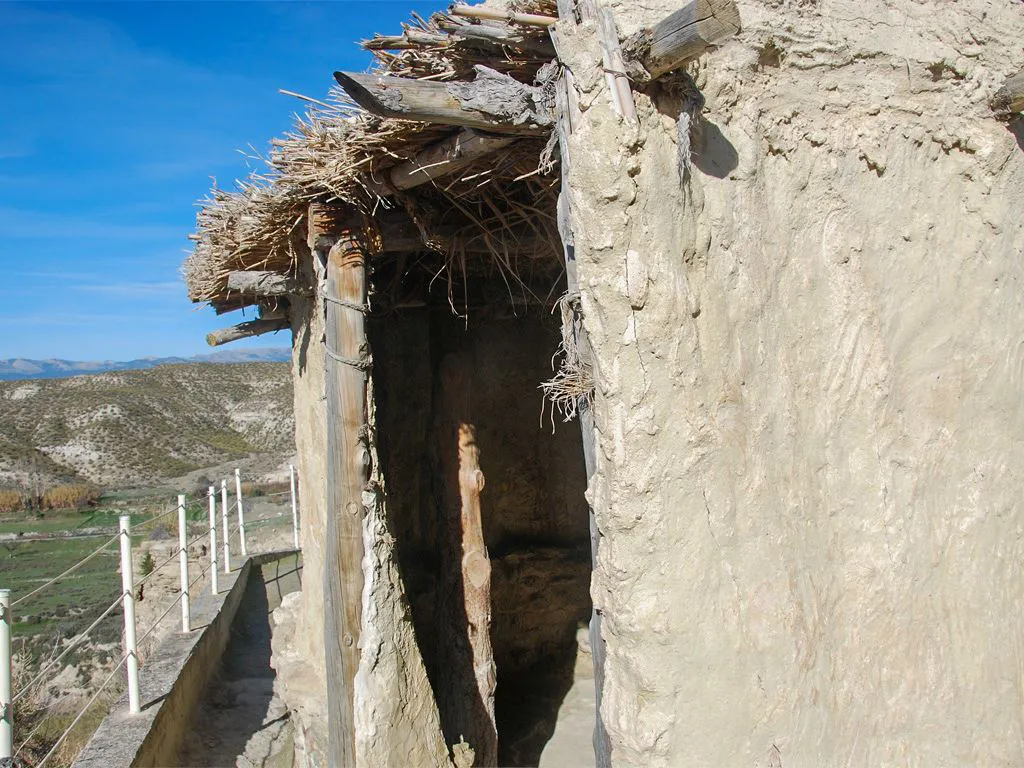
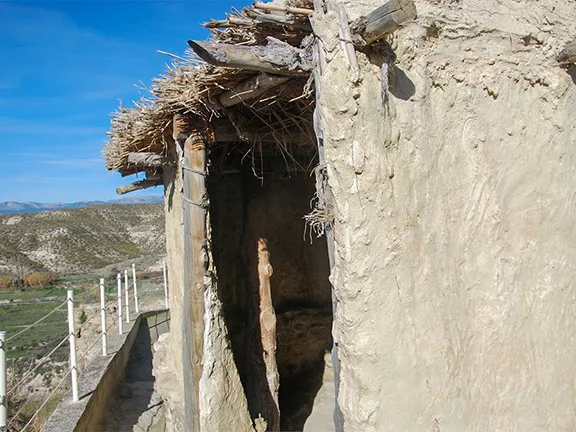
Argar dwelling
Barely had the Argarian society reached its ultimate form about 1750 BC than it began to decline.
Studies reveal that at least half the major settlements were abandoned entirely with no evidence of continued occupation after a burnt layer in the strata indicates a fiery end to the settlement. The same settlements similarly show no evidence of re-occupation. No particular significance should be inferred from the burnt layer. Many communities in Europe at this time ritually burnt their settlements prior to moving on.
According to the 14C dates, of which there are around 330 in total covering 16 settlements, three settlements out of the 16 were abandoned shortly after ca. 1750–1700 BC These settlements were the lowland site of Los Cipreses, and two small to medium sized hilltop sites, Castellón Alto and Barranco de la Viuda. The acropolis at Castellón Alto must only just have been finished before the entire settlement was abandoned about 1700 BC.
Using the same sampling packages and dating, Punta de los Gavilanes and La Bastida were abandoned ca. 1640 and 1620 BC respectively. Interestingly these were two of the original founding centres of the Argar people. Recent investigations at La Bastida indicate that Punta de los Gavilanes was within the territory controlled by La Bastida, which could account for their near simultaneous abandonment.
Recent excavations have revealed another Argar construction near La Basitida. It is a large architectural complex of almost 1000 square metres in area, on the hill of Tira del Lienzo. This might have functioned as a fortified administrative outpost of La Bastida. In this rectangular building dominating the top of the hill, a silver sheeting workshop has been identified as well as series of rather narrow storage rooms and specialised activity areas surrounding the central building. As with La Bastida, Tira del Lienzo was abandoned between 1600 and 1550 BC and never re-occupied during prehistoric times.
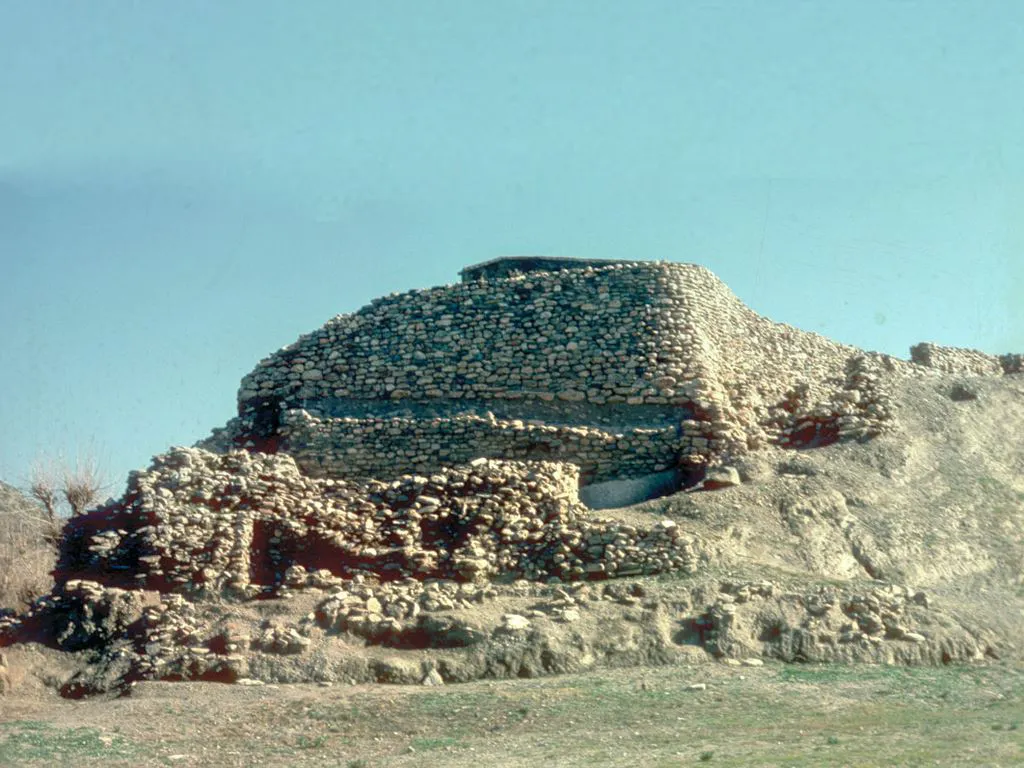
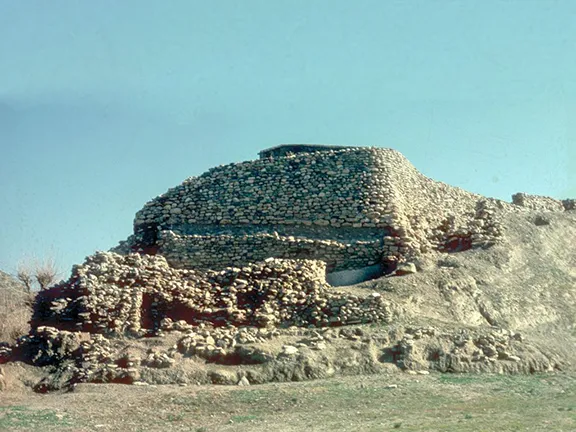
Cerro de la Encina
Following this apparent population re-organisation, there is a hiatus of about 60 years, two to three generations, before we see the abandonment of the remaining settlements, between 1540 and 1500 BC. In the order they were apparently abandoned, Illeta dels Banyets (1538), El Picacho (1535), Cerro de la Virgen (1535), Cerro de la Encina (1530), Gatas, Cabezo Pardo and Cabezo Negro around 1522, followed around 1510 by Cuesta del Negro, Penalosa, Cerro de la Encantada. and Murviedro.
The acropolis at Cerro de la Encina was destroyed by fire at the end of the Argarian period. The tower at Fuente Álamo was abandoned and apparently dismantled before 1550 BC for some unknown reason.
All the dates are in the process of being revised due to confirmed technical problems in the processing of the samples. The dates shown here may be out by up to 50 years however, the sequence of the abandonments and the number of years over which they occurred is likely to be correct.
If this pattern is confirmed by future investigations, it would imply that the final phase of El Argar started with territorial re-organisation and population movements throughout the territory, a hiatus and then a final, rapid period of abandonment that generally started in the outer borders of the territory, apart from the mineral areas in Jaen and Cuidad Real that were presumably valuable and retained, withdrawing into the centre of the territory around the Almanzora river estuary and Lorca.
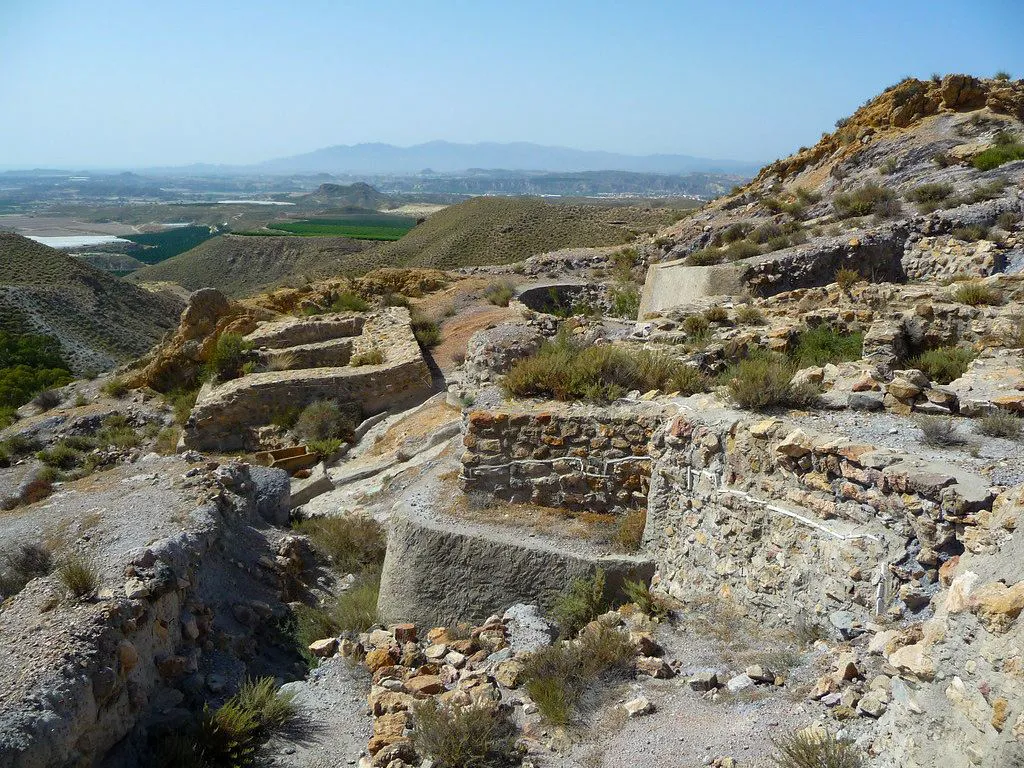
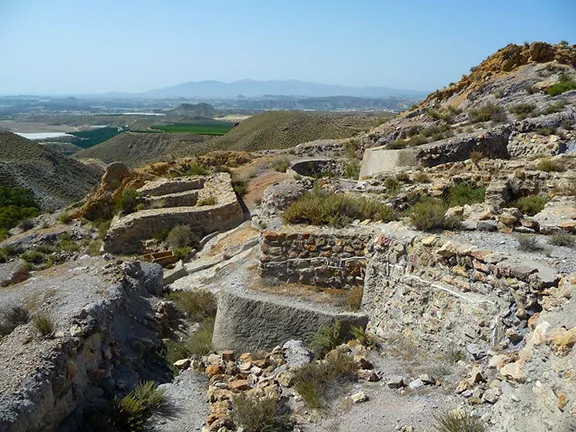
Fuente Alamo
Settlement densities give some idea of how the population coped with the end of their society. In the fertile valley and estuary of the Rio Almanzora in present day Almeria, a core region of the Argarians, the total number of settlements before and after 1550 BC is about the same. The same cannot be said for areas such as the northwest of present-day Murcia where a total lack of post 1500 BC settlements indicates a disbanded, highly mobile population that left no archaeological traces of its passing.
There is one notable and interesting exception. Only one group is so far known to have tried to emulate that which had gone before. At Cabezo Redondo (Villena, Alicante), beyond the north–western border of the former Argaric territory, the rise of an architectural and economic organisation can be traced from 1550 BC. It strongly resembles the aforementioned structures of late the Argarian society. The similarities between the buildings, infrastructures and macro-lithic assemblages is so marked, that the question emerges if formerly Argaric groups took shelter in the upper Vinalopó Valley after the 1550 BC collapse in an attempt to re-instate in this area the once known socio-economic system.
Along with the abandonment of their settlements, three of the most distinguishing features of the Argar period disappeared from the archaeological record.
• The intramural burial rite, which in its final phase followed strict norms of age, sex and class differentiation was abandoned.
• Specialised workshops and other monumental constructions in the few hilltop settlements that remained occupied, ceased (with one exception, see below).
• The diagnostic pottery types, such as a goblet with foot stand and the ‘S’ shaped vessels came to an end. At more or less the same time, newer, or at least different styles of pottery, known as Proto-Cogotas pottery, started to appear in some places.
That is not to say that all those markers disappeared from all Argaric settlements at the same time. For instance, it appears as though monumental building at La Fuente ceased sometime before the last of the intramural burials took place and before any new pottery production began. Regarding the introduction of new decorative styles on pottery; to date, from a limited number of 14C samples in a number of sites, it seems as though the Proto-Cogotas style and types crept in from the northwestern fringes of the territory controlled by the Argarians, via Peñalosa (Jaén).
Not all the settlements were abandoned. A few showed signs of continued occupation; Murviedro near Lorca in Murcia, Fuente Álamo in the Almanzora river valley in Almeria and Gatas near Mojacar in Almeria, have been studied.
Gatas is one of the few Argaric sites to show new monumental construction after the presumed end of the Argaric period. Travertine rock, excavated some way from the site, was used to build a wall, 14 metres long and 1 metre wide. The function of this structure is still unclear as the inner space has not yet been explored. However, the living area extending in front of it included six functioning and five broken grinding slabs arranged in groups of two to four, as well as a stone mould, metal sharpeners and other stone tools.
At Fuente Alamo, the rectangular dwellings were replaced by smaller, more irregular buildings that had different functions to their predecessors. Inside those new structures, similar or identical micro-lithic tools have been found in each dwelling indicating no specialisation of activity. Uncoordinated activity as opposed to the Argaric strict control. Over half the structures at Fuente Álamo also had artefacts relating to the smelting and moulding of metal, items missing from Argaric settlements where the metal working activities in the workshops was confined to forging, polishing and sharpening metals extracted from the ore near the source (Peñalosa). Similar signs of widespread, uncoordinated small scale working of metals also occur at Gatas and Murviedro (that was apparently abandoned as mentioned earlier and then almost immediately re-occupied).
Cuesta del Negro, in Granada province, was abandoned and then re-occupied some 50 to 100 years later. One date obtained from Punta de los Gavilanes indicates it may have had a similar history as Cuesta del Negro.
The evidence suggests that the disintegration of a strictly controlled society apparently allowed local communities to follow different economic, social and political developments.
From the settlement occupation records, it appears as if the Argarian society disappeared rather abruptly. That abruptness indicates a calamitous end. In the absence of any natural disaster, for instance severe floods, plague or volcanic eruptions, or evidence of an invading force, such an abruptness indicates a human cause from within. As a quick aside, some historians still point to the eruption of the Thera volcano in 1646 BC as a contributory factor towards the demise of the Argarian society, the theory being that a long winter caused by ash in the atmosphere, caused crops to fail for a number of years. No geomorphological or botanical records support this theory. However, starvation may have been a factor for other reasons.
As we have seen from the agricultural and land use record, the land was first of all cleared of native species, then planted predominantly with barley for a few years and then abandoned to allow secondary, scrubby, vegetation to recolonise the ground. It is possible the Argarians ran out of available land. The result would be increased demand for less food and starvation of the lower echelons of the society whilst the upper echelons maintained, or even increased, their lavish lifestyle, as evidenced by the rich burials dating from the latter part of the Argar period. In any case the gap between ruled and rulers would widen. The depletion of natural resources frequently goes hand in hand with social exploitation when surplus production has become the driving economic force.
In the absence of any other explanation, I propose that land depletion led to starvation. There would be increasing discontent about the inequities of the society, ultimately leading to a ‘peasants revolt’ that spelled the end of the Argarian society.
Throughout the period the Argarian society existed, outside the territory controlled by the Argarians, particularly westwards through Andalucia, there were many, as far as we can tell, settled, rural communities. None of those communities managed to coalesce into anything that may be termed a society.
The disintegration of the Argar society was basically just that. The people from the settlements dispersed into the surrounding areas with notable exceptions already mentioned. The people that built the motillas in La Mancha, north of the Argar territory, survived the Argarians by perhaps 300 years. The Argaric group that apparently evacuated to Cabezo Redondo only lasted a couple of hundred years.
The previously Argaric settlements that continued to be occupied, or that were re-occupied after a few years, saw a completely different type of inhabitant. There is no sign after the Argarians had gone of a resumption of their customs, ritual or way of life.
One immediate effect was that the monoculture of barley was abandoned and the succeeding communities reverted to a mixed agricultural policy.
Some of the Argarian customs, such as their burial rites and their metals technology, survived in widespread settlements with one notable policy difference. The metallic ores were processed in scattered settlements, there is no apparent control of the raw material or the metal produced.
It was to be another five hundred years after the Argarian society disappeared before anything resembling a society re-appeared in the southwest of the Iberian peninsula and that happened in the western parts of Andalucia with the emergence of the Tartessians. People in eastern Andalucia had to wait another couple of hundred years before they became part of the Iberian society.
References and further reading
Aranda-Jiménez, Gonzalo & Montón-Subías, Sandra & Jiménez-Brobeil, Sylvia A.. (2015). Conflicting evidence? Weapons and skeletons in the Bronze Age of south-east Iberia. Antiquity. 83. 10.1017/S0003598X00099336.
Caramé, Manuel & Díaz-Zorita Bonilla, Marta & Sanjuán, Leonardo & Wheatley, David. (2010). The Copper Age Settlement of Valencina de la Concepción (Seville, Spain): Demography, Metallurgy and Spatial Organization. Trabajos de Prehistoria. 67. 10.3989/tp.2010.10032.
Celma, Mireia & Stika, Hans-Peter. (2020). Circulation of olives, figs and grapes in the area of El Argar culture in south-eastern Spain. Journal of Archaeological Science: Reports. 31. 10.1016/j.jasrep.2020.102366.
Díaz, María & Ramos, Ruth. (2018). La cosecha de El Garcel (Antas, Almería): estructuras de almacenamiento en el sureste de la península ibérica. Trabajos de Prehistoria. 75. 67. 10.3989/tp.2018.12204.
Hinz, Martin & Schirrmacher, Julien & Kneisel, Jutta & Rinne, Christoph & Weinelt, Mara. (2019). The Chalcolithic–Bronze Age transition in southern Iberia under the influence of the 4.2 ka BP event? A correlation of climatological and demographic proxies. 10.12766/jna.2019.1.
Lull, Vicente & Rihuete, Cristina & Micó, Rafael & Risch, Roberto. (2013). Political collapse and social change at the end of El Argar.
Lull, Vicente & Micó, Rafael & Rihuete, Cristina & Risch, Roberto. (2013). The Iberian Peninsula during the Bronze Age. The Bronze Age in Europe. 594-616.
Montero Ruiz, Ignacio & Rovira Llorens, Salvador & Delibes, Germán & Fernández-Manzano, Julio & Herrán, José & Fernández-Posse, Mª & Martín, Concepción & Maicas, Ruth. (2003). HIGH LEADED BRONZE IN THE LATE BRONZE AGE METALLURGY OF THE IBERIAN PENINSULA.
Murillo-Barroso, Mercedes & Bartelheim, Martin & Cortés, Francisco & Onorato, Auxilio & Pernicka, Ernst. (2012). The silver of the South Iberian El Argar Culture: A first look at production and distribution. Trabajos de Prehistoria. 69. 293-309. 10.3989/tp.2012.12093.
Olalde, Iñigo & Brace, Selina & Allentoft, Morten & Armit, Ian & Kristiansen, Kristian & Rohland, Nadin & Mallick, Swapan & Booth, Thomas & Szécsényi-Nagy, Anna & Mittnik, Alissa & Altena, Eveline & Lipson, Mark & Lazaridis, Iosif & Patterson, Nick & Broomandkhoshbacht, Nasreen & Diekmann, Yoan & Faltyskova, Zuzana & Fernandes, Daniel & Ferry, Matthew & Reich, David. (2017). The Beaker phenomenon and the genomic transformation of Northwest Europe. bioRxiv.
Risch, Roberto. (2014). The La Bastida fortification: new light and new questions on Early Bronze Age societies in the western Mediterranean. Antiquity. 88. 395-410. 10.13140/2.1.2131.0082.
Risch, Roberto & Lull, Vicente & Micó, Rafael & Rihuete, Cristina. (2015). Transitions and conflict at the end of the 3rd millennium BC in south Iberia. 10.13140/RG.2.1.3881.1286.
Valdiosera, Cristina & Günther, Torsten & Vera-Rodríguez, Juan Carlos & Ureña, Irene & Iriarte, Eneko & Rodríguez-Varela, Ricardo & Simões, Luciana & Sánchez, Rafael M & Svensson, Emma & Malmström, Helena & Rodríguez, Laura & Castro, José-María & Carbonell, Eudald & Alday, Alfonso & Vera, José & Götherström, Anders & Carretero, José-Miguel & Arsuaga, Juan & Smith, Colin & Jakobsson, Mattias. (2018). Four millennia of Iberian biomolecular prehistory illustrate the impact of prehistoric migrations at the far end of Eurasia. Proceedings of the National Academy of Sciences. 115. 3428–3433. 10.1073/pnas.1717762115.
Vilaça, R. & Bottaini, Carlo. (2019). Breaking metals and handling ideas about Bronze Age Hoards from Western Iberia. Material patterns, invisible behaviors and possible interpretations, In A. Valera (Ed), Fragmentation and depositions in Pre and Protohistoric Portugal, pp. 125-139.
MUSEO DE GALERA. Guía Oficial Septiembre de 2007